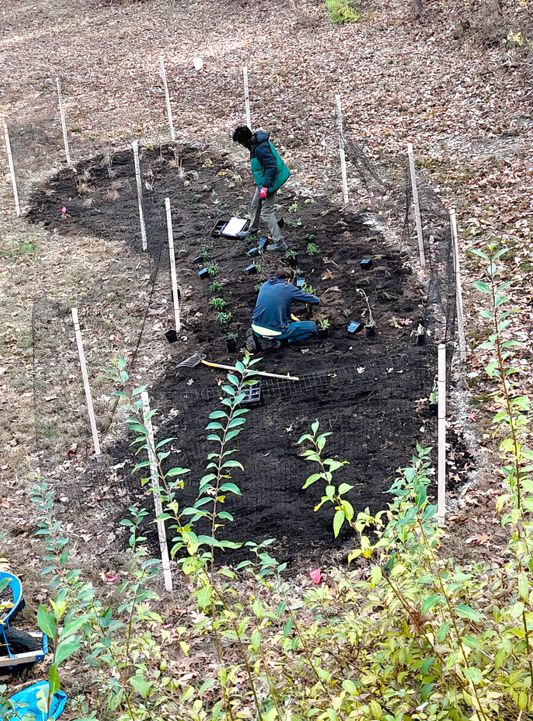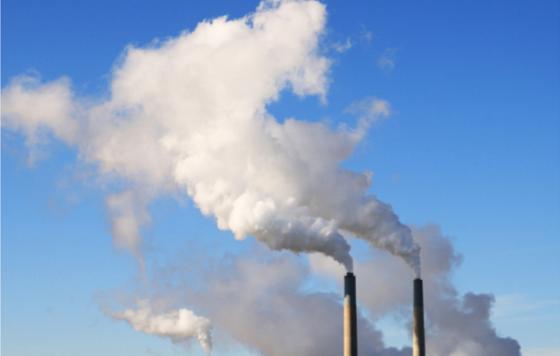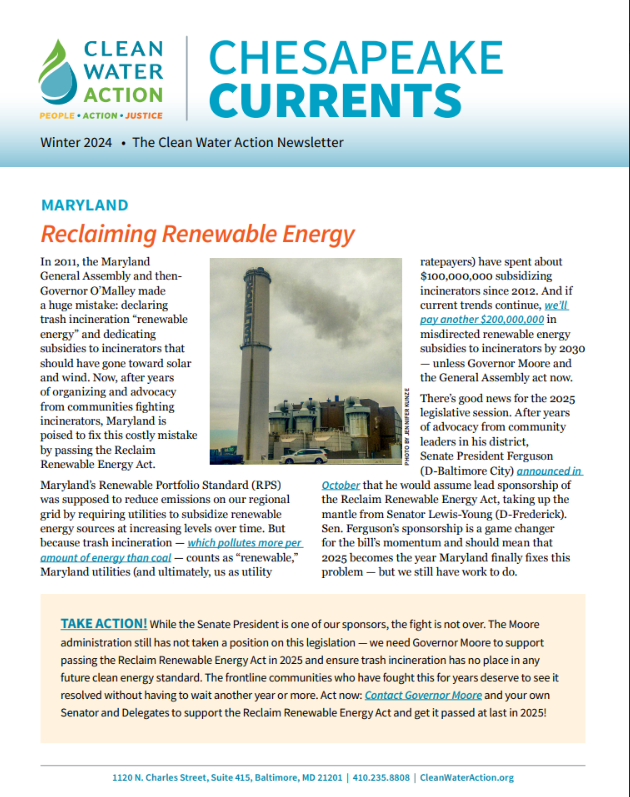In this Issue:
- National Updates
- Maryland Prepares New Heat Stress Standard
- Emergency Help for Sewer Backups
- Legislative Recap
- Zero Waste in Baltimore
- Septic Systems in the Chesapeake
- Anacostia Park and Community Collaborative General Meeting
National Update
Victory After Ten Years of Clean Water Advocacy: EPA Strengthens Coal-Fired Power Plant Water Pollution Limits
On April 25, 2024, the U.S. Environmental Protection Agency (EPA) finalized more strict Clean Water Act wastewater pollution limits (also known as Effluent Limitations Guidelines or ELGs) for coal-fired power plants. Our press release describes the details of the new rule, which will prevent millions of pounds of harmful pollution from being released into our waterways each year, protect drinking water sources for more than 42 million people, reduce costs for drinking water systems and their customers, and ensure a healthier future for all communities. As highlighted in one of our latest blog posts, this win is the culmination of more than a decade of advocacy by Clean Water Action and its hundreds of thousands of members across the country.
A Year Since Devastating Sackett v. EPA Decision: Colorado Leads the Way in Restoring State Protections to Wetlands and Streams
The U.S. Supreme Court issued its decision in the case of Sackett v. EPA on May 25, 2023. This ruling narrowed the Clean Water Act’s definition of “Waters of the United States” by removing protections from most wetlands and streams. Clean Water Action has been working to fill the gap from the loss of these federal protections by advocating on the state level. We recently celebrated a hard-fought win in Colorado with the passage of House Bill 24-1379, which strengthened protections to wetlands and streams (see our blog here). While this was a victory for clean water on the state level, we ultimately need Congress to pass legislation to permanently restore protections to all vulnerable waters and wetlands across the country. You can help by taking action today: urge your U.S. Representative to support a national fix to the Clean Water Act.
Maryland Prepares New Heat Stress Standard
Four years ago, Maryland’s General Assembly passed legislation to require a heat stress standard designed to keep workers safe. Maryland OSHA, under Governor Hogan, created a sorely inadequate standard in 2022, and we urged the state to withdraw the standard and issue a new one. Governor Moore’s Department of Labor made commitments to fix the problem, withdrawing the inadequate standard and releasing a draft standard that will require actual practices to protect workers both indoor and outdoor from dangerous heat conditions.
The new standard requires that employers have a heat illness prevention and management plan in writing and provide workers with annual heat stress training. The standard requires these plans to consider various effects, like required personal protective equipment or how strenuous labor is. As part of Marylanders for Food and Farmworker Protection, Clean Water Action is deeply concerned about farmworkers working in high heat, particularly pesticide applicators who require safety gear to reduce chemical exposure. Farmworkers face unique risks for heat stress due to chemical exposure, piecemeal pay, and long distances to bathroom facilities.
With Texas and Florida preventing local governments from creating worker protections, it's good to see Maryland join the ranks of states like California, Oregon, Washington, and Colorado in protecting workers from deadly heat. Federally, the Department of Labor’s Occupation Safety and Health Administration is developing its own heat stress standard.
Emergency Help for Sewer Backups
One year ago in May, the U.S. Environmental Protection Agency (EPA) and the Maryland Department of the Environment (MDE) ordered Baltimore City to do something we’ve been working with community organizations across the City to demand for a long time: to offer emergency assistance to all households facing sewage backups caused by city-owned infrastructure. But for the past year, the City has been fighting that order. And at an annual budget hearing last month, we learned that the City has only helped 18 households in the past two years.

TAKE ACTION! Tell EPA and MDE to keep upholding their original order and tell Baltimore City to back down. Baltimore residents deserve emergency assistance when City infrastructure causes sewage to flood backwards into their home.
Legislative Recap
At the start of Maryland’s legislative session in January, we were preparing to support three major issues. When the session ended in April, here’s where our top priorities landed:
✅ Transparency near Superfund Sites: The Superfund program’s National Priorities List identifies the country’s most hazardous contaminated sites for long-term study and remediation. Contamination from these sites can travel and threaten neighbors’ health, and neighbors need to know to take preventative measures to reduce their risk. HB486/SB125 ensures that people buying homes within a mile of a Superfund NPL site receive a disclosure notice, information about how to learn more about the site, and a 5-day right of rescission. This great bipartisan bill passed both chambers with overwhelming majorities.
❌ Reclaim Renewable Energy: We thought this was the year — Maryland’s climate plan, the Maryland Commission on Climate Change, local governments, and about 100 organizations all endorsed eliminating trash incineration from Maryland’s Renewable Portfolio Standard and redirecting the tens of millions of dollars of subsidies incinerators receive per year to real renewable energy instead. But despite such broad support, Governor Moore stayed silent on the bill, and neither the House nor the Senate brought it to a vote.
❌ Funding Waste Diversion & Compost: HB1318 would have created grant programs to support food waste rescue, diversion, and composting, and funded them through a $2/ton surcharge on dumping trash at a landfill or incinerator. We’ll keep working on this important Zero Waste bill next year.
During session, we sprang into action to successfully fight two more bills:
🚫 Fighting for real Environmental Justice: We opposed HB24/SB96 in solidarity with our partners in the Mid-Atlantic Justice Coalition (MAJC), because this bill — called an environmental justice bill – neglected air pollution and ignored the demands of frontline communities. As Meleny Thomas of Curtis Bay and Kamita Gray of Brandywine wrote: “Environmental Justice is not just a slogan to us. This bill gives the illusion of environmental justice. We need the real thing.” The bill did not pass, we’ll keep working with MAJC for meaningful progress on environmental justice.
🚫 Fighting greenwashed polluters: We opposed HB1407, which would have promoted all Tier 1 “renewable energy” facilities in Maryland and banned local governments from regulating them. Since the Tier 1 category includes trash incinerators, anaerobic digestors, and woody biomass facilities, this bill would have directly harmed frontline communities — and it wasn’t good policy for real renewable energy, either. When the bill was voted out of committee, we sprang into action alongside other environmental advocates and local governments. The bill was taken off the House’s vote list the next morning and it never moved forward.
Zero Waste in Baltimore
Baltimore City needs to build Zero Waste infrastructure, and that means budgeting for Zero Waste infrastructure. But in the FY2025 budget that Baltimore City adopted in June, there is no new funding for Zero Waste infrastructure and a 37% increase in the budget to burn trash at the incinerator. At another hearing about composting yard waste, the Department of Public Works asked to delay the bill’s effective date from 2025 to 2032. To learn more, read our testimony on the City’s budget and on yard waste composting.
Septic Systems in the Chesapeake

Native Gardens on Septic Fields:
With the Chesapeake Bay Trust and Howard County
government, Clean Water Fund installed two native
gardens on septic fields in Howard County. Thanks
to our partners at the University of Maryland and
Howard EcoWorks. PHOTO COURTESY WILLIAM BECK
Clean Water Action has been working with the University of Maryland for two years to design and install landscaping on top of septic systems to provide pollinator habitat and beautify lawns. Last year we worked with the university to design two gardens on septic systems, and Howard Eco Works installed the two projects. This year we are following up on last year’s gardens and designing and installing another two gardens.
This summer we also joined with members of industry and the University of Maryland Extension to present at the annual Choose Clean Water Conference about septic systems. The University of Maryland research farm in Howard County will soon have demonstrations and research septic tanks and drain fields, which will provide a hands-on opportunity for industry members and the public to learn more!
Virginia is about to update its septic regulations for the first time in twenty years. This comes just as Lake Anna suffered an e. coli outbreak over Memorial Day weekend. While no single cause of the outbreak has yet been identified, the Department of Health suggests that environmental pollution from heavy rains, livestock, failing septic systems, boating discharge, and swimmers themselves are potential sources.
▶ Maryland Organizer Gabi Sanchez, and her daughter Rosalie, tabled at the very popular Bowie Fest. Recently we have tabled at the Maryland Association for Environmental and Outdoor Education Youth Summit, a Bonnie Raitt concert, and Middletown Green Festival.
Anacostia Park and Community Collaborative General Meeting
Clean Water’s DC Partner, The Anacostia Park and Community Collaborative (APACC), held a virtual event on the History and impact of Water in Washington, DC. The event featured the work of Carmen Bolt, a doctoral candidate at American University, focusing on Environmental Justice and Public History. Her work is based on an ethics of care that centers the embodied experiences of those most vulnerable to environmental injustice. Her dissertation, titled “The Routine and the Extreme: A Critical Environmental History of Water in Washington, DC,” considers how water, conceived broadly, has shaped the history of Washington, DC’s communities of color over the course of the 20th and into the 21st century.

Carmen discussed the history of infrastructure and flooding in DC and the unequal impacts it has historically had on communities of color. She shared that the historical pattern has been to provide sewer and flood protection infrastructure to the wealthier and whiter parts of DC and exclude disfavored communities. Rather than providing support and infrastructure equitably around flooding and sewer systems through the 19th and 20th centuries, disfavored communities were forced out of their homes and in some cases out of DC entirely using language of “redevelopment,” sanitation, and health. Into the 21st century disfavored communities continue to be disproportionally impacted by flooding and sewage backup issues. This result is loss of property, and consistent risk to health and wellbeing. You can watch a recording of the event here!
Playing it Safe. Playgrounds should be safe and healthy places for children, but there has been a growing movement to install playground surfaces that include the use of synthetic surfaces, especially those that include synthetic turf and tire crumb/rubber. While on one hand these may seem like a good use of old tires, tire mulch commonly contains contaminants like lead, PFAS, and PAH. Learn more here.
Thank you for supporting our work in the Chesapeake Region.
DONATE
CURRENTS is published by Clean Water Action and Clean Water Fund. Reproduction in whole or part is permitted with proper credit. © 2023 All rights reserved.





